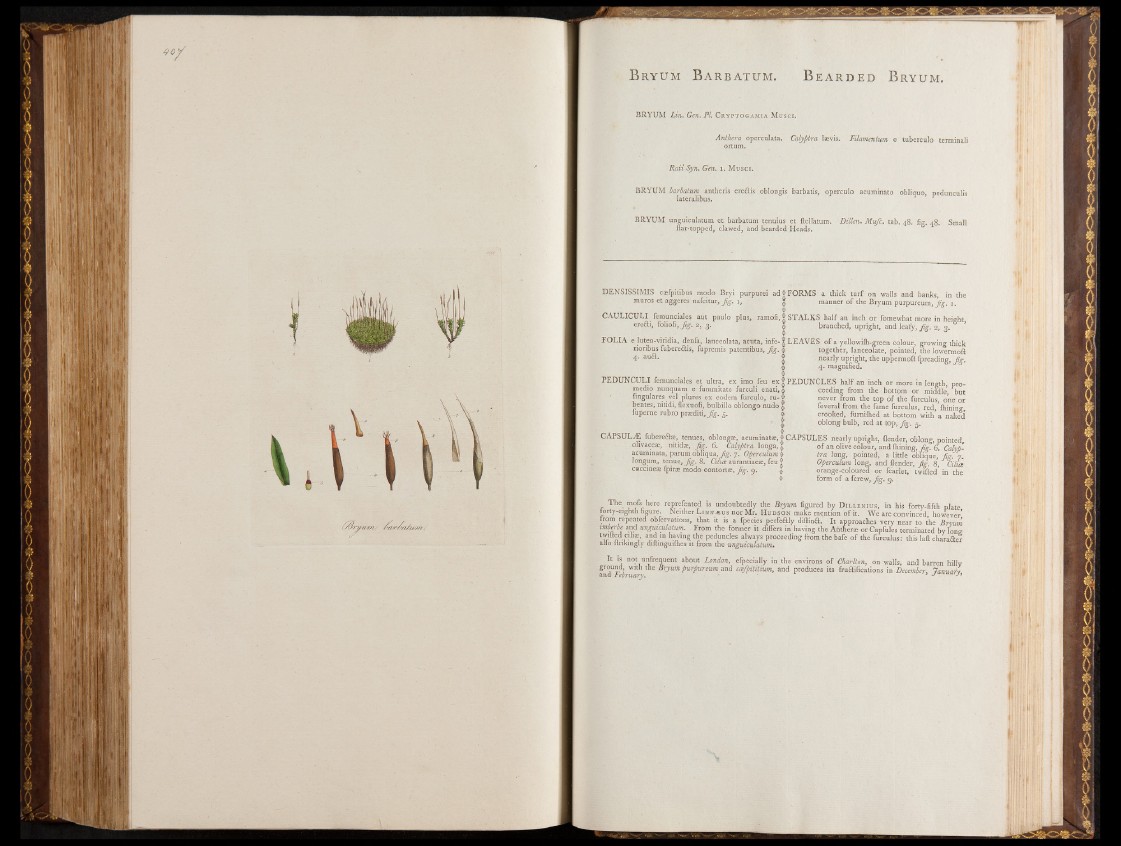
B ryum B a r b a t u m . B e a r d e d B r yum .
BRYUM Lin. Gen. PI. C r y p t o g a m ia M u s c i .
Anthera operculata. Calyptra laevis. Filamentum e tuberculo terminali
ortum.
Raii,Syn. Gen. 1. Musci.
BRYUM barbatum antheris ere&is oblongis barbatis, operculo acuminato oblique, pedunculis
lateralibus.
BRYUM unguiculatum et barbatum tenuius et ftellatum. Dillen. Mufc. tab. 48. fig. 48. Small
liar-topped, clawed, and bearded Heads.
DENSISSlMIS casfpitibus modo Bryi purpurei ad f FORMS a thick turf on walls and banks,
muros et aggeres nafeitur, Jig. 1, | manner of the Bryum purpureum, f i
CAULICÜLI femunciales aut paulo plus, - ramöfi, 1
ere6li, foliofi,fig. 2, 3. \
■ ■ i
FOLIA e Iuteo-viridia, denfa, lanceolata, acuta, infe-1
rioribus fubere&is, fupremis patentibus, fig. \
4. au£t. i
PEDUNCULI femunciales et ultra, ex imo feu e x j
medio nunquam e fummitate furculi enati,
fingulares vel plures ex eodem furculo, ru-v
bentes, nitidi, flexuofi, bulbillo oblongo nudo |
fuperne rubro praediti, fig. 5. |
I $
CA PSU LE fubereflae, tenues, oblongae, acuminatae,
olivaceae, nitidae, fig. 6. Calyptra longa,
acuminata, parum obliqua,^-. j . Operculum
longum, tenue, fig. 8. Cilice aurantiacas, feu
ceccineas (pirae modo contortae, fig. 9.
| STALKS half an inch or fomewhat more in height,
branched, upright, and leafy, fig. 2, 3.
. LE AVES o f a yellowilh-green colour, growing thick
together, lanceolate, pointed, the lowermoft
nearly upright, the uppermoft fpreading, fig.
4. magnified.
PEDUNCLES half an inch or more in length, proceeding
from the bottom or middle, but
never from the top of the furculus, one or
feveral from the fame furculus, red, fhining,
crooked, furnifhed at bottom with a naked
oblong bulb, red at top, fig. 5.
| CAPSULES nearly upright, {lender, oblong, pointed,
o f an olive colour, and fiiining, fig. 6. Calyptra
long, pointed, a little oblique, fig. 7.
Operculum long, and {lender, fig. 8, Cilice
orange-coloured or fcarlet, twilled in the
form of a ferew, fig. 9.
The mofs here reprefented is undoubtedly the Bryum figured by D il l e n iu s , in his forty-fifth plate
forty-eighth figure. Neither L innaeus nor Mr. H ud son make mention o f it. We are convinced, however*
irom repeated obfervations, that it is a fpecies perfe&ly diftinft. It approaches very near to the Bryum
imberbe and unguiculatum. From the former it differs in having the Antherae or Capfules terminated by Ion?
M B K i a™j.ln having the peduncles always proceeding from the bafe o f the furculus: this laft chara&er
alio itrikingly diftmguifhes it from the unguiculatum.
It is not unfrequent about London, efpecially in the environs of Charlton, on walls, and barren hilly
andU^ ? w _ y U^ Bryum PurPureum^and caefpititium, and produces its fruftifications in December, January,